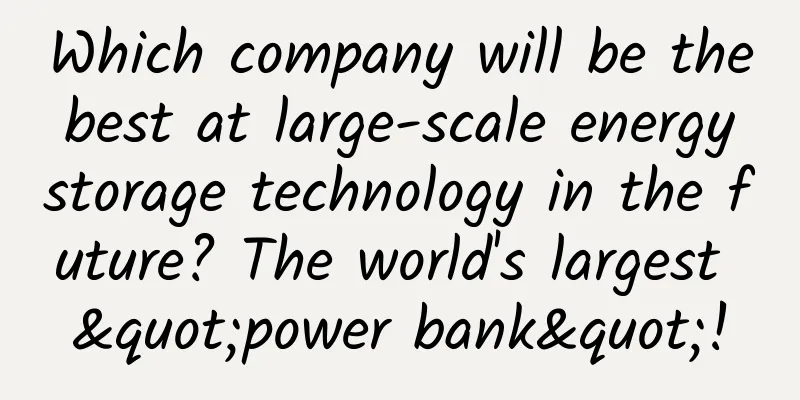Which company will be the best at large-scale energy storage technology in the future? The world's largest "power bank"!

|
Ren Shengquan Recently, the first domestically produced core control system in my country's pumped storage field has been operating safely for more than 25,000 hours on the modified units. The first artificial intelligence data analysis platform version has been updated and launched, and the remote centralized control mode of the units has been further applied, promoting the pumped storage industry to develop towards high-end, intelligent and green development. The No. 6 unit of the pumped storage power station will be installed and updated in Guangzhou in September this year. Pumped storage is the first choice for large-scale, large-capacity and long-term energy storage among various current energy storage technologies. Pumped storage is to artificially build two reservoirs, one high and one low. The upper and lower reservoirs do not flow continuously like the Yangtze River and the Yellow River, but are calm like a still lake most of the time. When the grid has sufficient electricity, such as when the sun is shining brightly at noon, a lot of electricity will be generated. At this time, the electricity price is cheap, and electricity is used to pump water from the lower reservoir and load it into the upper reservoir; when the grid is short of electricity, such as when photovoltaic power generation does not occur at night, the electricity price may be more expensive, and water is released from the upper reservoir to drive the units between the upper and lower reservoirs to generate electricity and send it to the grid, and the water then flows into the lower reservoir. Pumped storage is like a giant power bank, and its storage capacity is generally large. The energy stored in a typical pumped storage power station can fully charge about 120,000 electric vehicles. At the same time, the charging and discharging time of pumped storage is very flexible. A pool of water can be pumped up in 1 hour, and the water can be drained in 1 hour. The charging and discharging power is very large, and it can be charged and discharged "slowly", and it can also be combined to charge and discharge in accordance with the needs of the grid. Pumped storage is mostly located in areas with abundant water resources, while wind power, photovoltaic and other renewable energy generation are mainly concentrated in the three northern regions, mountainous areas and oceans, where it is difficult to obtain abundant water resources. At present, the development scale of pumped storage is far less than the growth rate of new energy power generation installed capacity. In addition to pumped storage, the capacity of energy storage devices such as electrochemical energy storage, compressed air energy storage, and flywheel energy storage is generally small, with high investment costs and short service life, and they are not the preferred solutions for large-capacity and long-term energy storage. Hydrogen energy storage is not restricted by region, has large capacity, long storage time, is not easy to decay, and is flexible to use, making it the focus technology for large-scale energy storage in the future. Hydrogen energy storage technology is developed by utilizing the interconversion of electricity-hydrogen-electricity. The basic principle is to electrolyze water to obtain hydrogen and oxygen. In renewable energy power generation systems, intermittent power generation and transmission constraints often occur. Large-scale hydrogen production using surplus, non-peak or low-quality electricity can convert electrical energy into hydrogen energy for storage. When power output is insufficient, hydrogen can be converted into electrical energy through fuel cells or other means and transmitted to the grid. This can effectively solve the problem of renewable energy power generation and grid connection under the current model. At the same time, the hydrogen produced in this process can also be distributed to other industrial fields such as transportation and metallurgy for direct use, thereby increasing economic value. In terms of energy utilization, hydrogen energy has a large capacity and long-term energy storage mode, which makes more full use of renewable electricity. From the perspective of scale energy storage economy, the cost of fixed-scale hydrogen storage is one order of magnitude lower than that of battery storage. In terms of battery discharge complementarity, hydrogen energy is a large-capacity, long-cycle flexible energy source. At present, there are many ways to store energy, but there seems to be no universal solution that can solve all problems. Looking at all large-scale energy storage technologies, hydrogen energy and pumped storage are likely to go hand in hand and be the focus of development in the future. (The author is a member of Anhui Science Writers Association) |
>>: Water celery or poison hemlock? Don't pick wild vegetables on the roadside
Recommend
Reminder! Heavy rain has returned early, please take precautions!
The holiday is coming to an end Good weather &quo...
Evergrande invested 14.5 billion in Guanghui, in addition to opening up sales channels for FF, it also has greater ambitions
On the evening of September 23, China Evergrande ...
One-minute science | Why do plants in the desert grow in such strange shapes?
What are desert plants? Desert plants generally r...
4 Misconceptions of APP Acquisition of Users, Have You Fallen into Them?
Regardless of whether users are easy to dig, avoi...
Manufacturers are flocking to AI mobile phone chips, and what they value is the value behind it.
In the past two years, artificial intelligence te...
I really want to ask: How is the ban on honking captured?
With the acceleration of urbanization, traffic pr...
D, GO, Rust, which one will replace C in the future? Why?
Never mind my position as one of the creators of ...
Nongfu Spring’s new advertisement is amazing!
"We don't produce water, we are just nat...
There are so many benefits of eating tofu in spring! But these two types of people are not suitable for eating it~
Tofu is a traditional food in my country. It is a...
The mass extinction of 3-meter-tall prehistoric giant apes is actually related to their "picky eating"?
The mystery of the extinction of Gigantopithecus,...
How much does dog meat cost per pound in 2021? How much does cooked dog meat cost per pound now?
With the arrival of National Day, the weather in ...
Ministry of Industry and Information Technology: Vigorously safeguard personal information security and achieve fundamental improvement in the consumption environment
Recently, the Ministry of Industry and Informatio...
Snow leopards have been spotted in Beijing? Scientists reveal the secrets of snow leopards' unique evolution
The Institute of Vertebrate Paleontology and Pale...
When will the 2020 epidemic end and when will the 2020 epidemic be lifted?
I want to go out, but when is it safe? Will the e...
Tencent is not the rival of China Mobile, China Telecom and China Unicom. Will 5G messaging rebuild the Internet ecosystem?
Many times, once you stand on the high ground of ...









